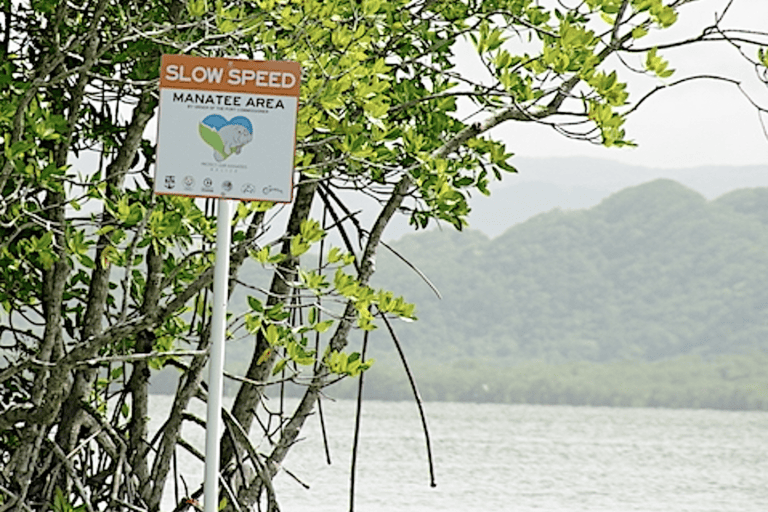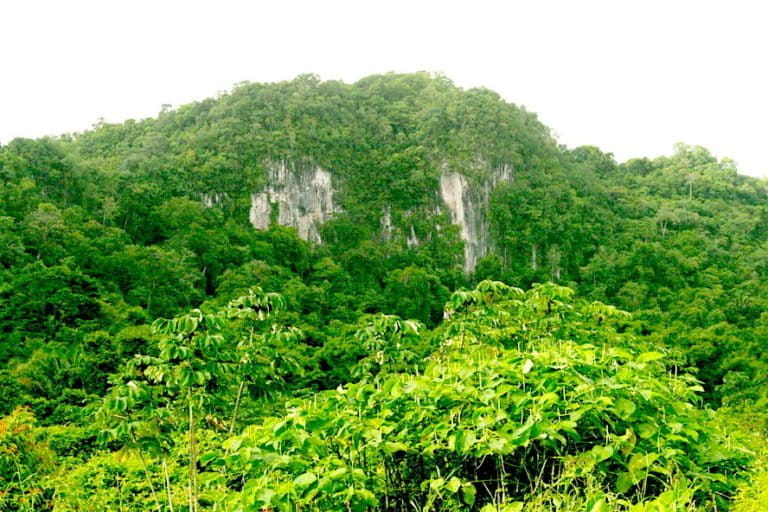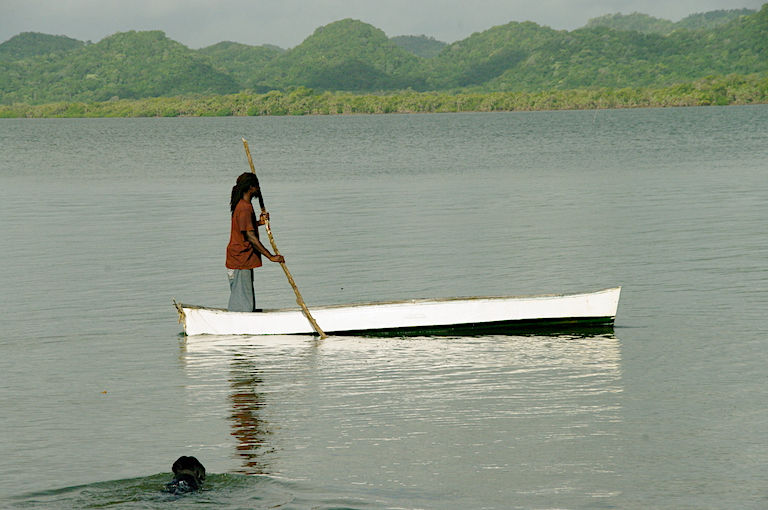- Southern Lagoon lies on Belize’s central coast and sustains a large breeding population of manatees, fish, birds and other wildlife that supports the local community and attracts tourists.
- The limestone hills adjacent to it have also drawn the attention of Vulcan Materials, an Alabama-based company that wants to mine the hills for limestone to ship to the U.S., after its mine in Quintana Roo was shuttered by the Mexican Government for environmental degradation.
- Community resistance to the planned mine and its likely negative effects on the area’s natural beauty and tourism economy has been increasing: the nation’s Prime Minister and three members of the House of Representatives also oppose it, yet the company continues to pursue it.
- This post is a commentary. The views expressed are those of the author, not necessarily Mongabay.
Belize is an amazing country where warm, humid jungles, cool tropical rivers, mangrove forests, and wildlife abound. I am an ecologist drawn to Belize as a special place where I can escape into deep wilderness. To walk a jungle trail used by jaguars and tapirs while raucous flocks of parrots angrily scold the world as they storm overhead exhilarates me. I relish my time in Belize.
Thus, I am excited by Belize’s growing conservation efforts and push towards developing a sustainable ecotourism economy. Belize is making great strides setting aside tracts of land for national parks, wildlife refuges, and preserves. In addition, privately-owned preserves are on the rise. Recent efforts include expanding the Maya Forest Corridor as an essential part of the Jaguar Corridor Initiative, which is establishing protected habitat from northern Mexico to Brazil. This year, Belize signed a Blue Bond Agreement; the first of its kind. In this agreement, developed by The Nature Conservancy, Belize agreed to a financial transaction enabling a $364 million reduction in debt burden and in so doing generating a potential $180 million for marine conservation including protection of 30% of Belize’s coastal waters.
An environmentally sensitive region south of Belize City is where a series of brackish water lagoons are less than a mile inland from the Caribbean Sea. Some of these lagoons are within the Gales Point Wildlife Sanctuary comprised of 22 terrestrial and aquatic ecosystems. One of the purposes of the sanctuary is to protect the endangered Antillean manatee and two critically endangered species (Central American river turtle and the goliath grouper). Other endangered species residing in the sanctuary include the Mexican black howler monkey, Baird’s tapir, and yellow-headed parrot. Between the lagoons and the sea is a strip of shoreline that is the most important nesting area for the critically endangered hawksbill sea turtle, the endangered green sea turtle, and the threatened loggerhead sea turtle.

The Southern Lagoon, within the sanctuary, sustains a large breeding population of Antillean manatees. They spend their days munching on turtle grass and manatee grass, floating in warm waters rising up from thermal vents and swimming to the Manatee River, encountering Morelet’s crocodiles along the way, for their daily drink of fresh water. Along the lagoon’s western shore are a series of sharp, steep limestone hills looking like giant, green crocodile teeth protruding from the earth. Some have vertical faces of glowing white limestone; one so white it is called Sugar Valley Hill. Hidden caves are scattered among these hills, their locations known only by a few villagers; some still contain Mayan artifacts.
A thin peninsula called Gales Point resembling a bony, gnarled finger thrusts northward into the lagoon. Here, 250 inhabitants reside in Gales Point Manatee Village. The village has a deep history and strong Creole culture with unique traditions. Fishing, farming, and the making of crafts are the sources of income. Hopes abound that a sustainable eco-cultural tourism economy will come to the village with completion of the Coastal Road, making the region more accessible for tourists.
This summer, I spent time at Gales Point and the Southern Lagoon. John “The Tarpon King” Moore gave me a boat tour of the lagoon where I saw a multitude of manatees briefly surfacing for quick breaths. We visited the mouth of the Manatee River flowing into the lagoon. We followed the Bar River to the Caribbean Sea as schools of silvery tarpon surfaced with their large scales, each a mirror, scattering bright rays of sunlight in all directions. From the ocean, we could see the strip of sandy beach where sea turtles nest and jaguars prowl along the edge of the jungle. I found the Southern Lagoon and Gales Point Manatee most enchanting. I left with hopes for the villagers’ happiness and prosperity.

Limestone vs. legacy
Many of the limestone hills lining the Southern Lagoon are part of the 15,000-acre White Ridge Farm, which includes land extending to the coastline. These hills have drawn the attention of the Vulcan Materials Company (VMC) based in Birmingham, Alabama. VMC wants to mine the hills extracting limestone for shipment to the U.S. Currently the ink is drying on VMC’s purchase of the controlling shares of the farm. VMC already has conducted core drilling of hills near the Southern Lagoon to assess the quality of granite and limestone. The proposed plan is to first mine Sugar Valley Hill on the south side of the Coastal Road, then progress northwest. The crushed rock will be transported by an above-ground conveyer belt along the road, then over it to the coastline, where a concrete pier will be constructed. The seabed will be dredged for massive 750-foot Panamax self-loading ships to approach the shore for loading.
VMC promises good paying jobs for the villagers and to protect and contribute to the environmental health of the region. They say it will be a responsible steward with respect for the safety and environmental impact of their operation. VMC claims they will work to earn the respect and trust of all parties involved by acting fairly and honorably. This sounds like a win-win for the village, the sanctuary, and the environment. However, most villagers and other Belizeans have concerns that these claims and VMC’s future actions will not match. There is no shortage of evidence for concern.
Recently a limestone quarry owned by Vulcan near the resort town of Playa del Carmen in the Mexican state of Quintana Roo was shut down by the Mexican Government. This was for environmental problems including contamination of groundwater.

In Texas, the grassroots organization Stop 3009 Vulcan Quarry is fighting to prevent a new quarry between Austin and San Antonio. The organization cites problems at Vulcan’s Loop 1604 plant in San Antonio and their asphalt plant in Helotes. Eighty formal complaints have been filed against the Loop 1604 plant with the Texas Commission on Environmental Quality since 2002. This plant has 35 violations of air, storm water, and wastewater regulations.
Stop 3009 lists the myths perpetuated by Vulcan, firstly that Vulcan is a good neighbor. The complaints and violations noted above say otherwise. The second myth, that Vulcan plants and quarries bring many good paying jobs. Yet, VMC predicted the 3009 Quarry will create 15 to 20 full-time jobs at full production. Third myth, the 3009 Vulcan Quarry will increase property tax revenues. Yet, in 2017 the 1077-acre loop 1604 plant generated just $19,000 in tax revenue for Bexar County Texas, and $87,000 for the Northeast Independent School District. Stop 3009 points out that the 6,364 properties (both homes and ranches) within five miles of the proposed quarry are valued at $1.7 billion. It is estimated these properties will lose 20% of their market value because of the quarry, resulting in a loss of $2 million in property tax revenues each year.
Vulcan has also been problematic elsewhere. In Illinois, VMC settled a 2001 lawsuit for $40 million stemming from damage to a road that intersected the quarry. Furthermore, the online source Violation Tracker shows that since 2000 Vulcan has had 124 violations, of which 32 were environmentally related, 82 workplace and health related, and eight employment related. Yet, the fines paid for these violations totaled only $4.4 million.

Because of Vulcan’s history of causing environmental problems, substantial damage could very well impact the Gales Point Sanctuary, the Southern Lagoon, the sea turtle nesting area, the marine ecology, and any hopes of sustainable eco-cultural tourism.
Dr. Ed Boles is an aquatic ecologist who has worked in Belize for decades. He has written a critical 30-page document detailing the expected impact a limestone quarry would have on the region based on published research on problems arising from limestone surface mining. The potential risks are extensive. This document is a must read by all those in Belize concerned that Vulcan’s mining the hills will impact water quality, air quality, and damage both terrestrial and marine ecosystems. The potential to erode the sea turtle nesting area and inflicting harm on the manatee population in the lagoon is simply too great to dismiss.
Limestone is a water-porous rock with cracks, caves, and caverns that create aquifers, water storage, and water purification. Blasting and mining will collapse caves where Mayan artifacts still remain, damage and alter ground water flow through the karst, contaminating springs and artesian wells, which may dry up altogether. Sedimentation from mining and altered surface water runoff will damage the streams and rivers feeding the Southern Lagoon. The conveyer belt will cause dust and debris along its path, damaging both the ecology and aesthetics of the surroundings.

Dredging the seabed has the potential for massive environmental damage, causing shifts in current patterns possibly leading to erosion and loss of the hawksbill nesting area. Dredge spoil will bury portions of the sea floor’s benthic life. Once dredging is complete, more problems could arise. The risk of vessels running aground and damaging reefs and sea grass beds will be ever present. Bilge water discharge into the Inner Canal along the coast can release heavy metals, hydrocarbons, and other pollutants, while the increase in boat traffic will cause water pollution. Offshore refueling will increase risks of fuel spillage. All of these are threats to the hawksbill nesting area. Furthermore, these activities will be in violation of the Blue Bond agreement.
Both blasting the limestone hills and crushing the rock into the desired aggregate sizes will release toxic gases and harmful particulates like silica dioxide. Habitat loss and degradation to both terrestrial and marine ecosystems during this process will lead to wildlife dead zones.
Industry-related housing and traffic of heavy mining equipment will lead to further loss of the region’s natural beauty. Any hopes of sustainable eco-cultural tourism are lost forever. In turn, it will become increasingly difficult for the villagers to sustain and promote their culture. Mining the Southern Lagoon’s limestone hills will be history repeating itself: large, wealthy corporations arriving in small countries to extract natural resources, then leaving behind a depleted region at the cost of the indigenous culture. At some point, humanity needs to rise above this pattern of greed and destruction.
John Antonio Briceño, the Prime Minister of Belize, opposes the proposed mining as do three members of the House of Representatives including Dolores Balderamos Garcia (Minister of Human Development, Families, and Indigenous People’s Affairs), Cordel Hyde (Minister of Natural Resources, Petroleum and Mining), and Anthony Mahler (Minister of Tourism and Diaspora Relations).
See related interview with Belize Fisheries about sharing the bounties of a marine reserve while pursuing conservation, here

It may appear that Vulcan can be stopped from mining this area for now. However, Vulcan is in it for the long game knowing current controlling political parties eventually lose power, politicians eventually leave office, and political winds might shift in favor of mining. There are those aspiring to high political office in Belize who favor mining. On the 20th of August 2022, representatives of Vulcan had a second meeting of the summer with the villagers of Gales Point. Concerned Belizeans living along the Coastal Road attended. I have communicated with some attendees. The Vulcan representatives made it clear their mission is “to take those hills.” Others fear White Ridge Farm’s purchase is because of Vulcan’s confidence the hills will be mined. The threat Vulcan poses to the region is serious. If they mine, an ecologically fragile landscape where endangered species have a stronghold will become an industrialized landscape.
Public awareness of potential problems mining could cause, and the long-term vision, must be maintained. Currently, Vulcan is facing growing opposition in Belize. But this battle is long from over. National and international organizations along with NGOs need be made aware of the threat mining poses, and that their assistance is needed. Keeping politicians aware and informed of the environmental and cultural damage mining will cause is critical. This is a looming threat that will persist until Vulcan sells White Ridge Farm to those who understand that using it to develop a sustainable, eco-cultural tourism economy is better for the future and prosperity of those who live in the region. Only then will a fragile environment with rare species be safe and protected.
James Krupa is a biologist and award-winning professor in the Department of Biology at the University of Kentucky-Lexington.
Related audio from Mongabay’s podcast: Mexico’s Maya Train is a multi-billion dollar, 958 mile-long railway project that threatens to displace communities and degrade natural habitats across five states in the Yucatán peninsula of Mexico. Are these costs worth the benefits? Listen to a discussion with our Mexico City-based reporter, here,
See more from this writer:
Huge wildlife corridor in Belize sees progress, boosting hope for jaguars and more (commentary)